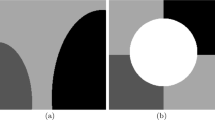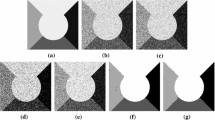Abstract
Aiming at the poor anti-jamming effect of traditional fuzzy c-means clustering image segmentation method, a fuzzy c-means clustering image segmentation algorithm based on Hidden Markov model is proposed. Hidden Markov model is used to extract the model state, observation state, initial probability, transition probability and visible symbol probability parameters of fuzzy c-means clustering image. According to these parameters, the image texture is measured, and the image mean is removed to eliminate the influence of brightness. Then the image features are extracted by combining the standard deviation. Through the color space and convert it from RGB model to his model. On the basis of removing the image noise, the image is smoothed to achieve image segmentation. Experimental results show that the algorithm has good segmentation effect, smooth segmentation boundary, little influence of image noise and strong robustness.




Similar content being viewed by others
References
Zishuo H, Chunping W (2019) SAR image segmentation based on improved FCM and MRF. Syst Eng Electron 41(8):1726–1734
Quan Z, Yu W, Jia L et al (2019) An open-source project for real-time image semantic segmentation. Sci China (Inf Sci) 62(12):246–247
Kai K, Xiuhong C (2019) Fuzzy C-means clustering image segmentation algorithm with local spatial Infor-mation based on ELM. J Data Acquis Process 34(1):100–110
Yanming L, Xin Y, Chao L (2019) Image segmentation algorithm of colorimetric sensor array based on Fuzzy C-means clustering. Comput Syst Appl 28(6):110–117
Punit R, Bezdek JC, Erfani SM et al (2018) Ensemble fuzzy clustering using cumulative aggregation on random projections. IEEE Trans Fuzzy Syst 26(3):1510–1524
Liang C, Paul B, Kensaku M et al (2018) DRINet for medical image segmentation. IEEE Trans Med Imaging 37(11):2453–2462
Wen F, Wu N, Gong X (2020) China’s carbon emissions trading and stock returns. Energy Econ 86:104627
Geng Q, Zhou Z, Cao X (2018) Survey of recent progress in semantic image segmentation with CNNs. Sci China (Inf Sci) 61(5):107–124
Feng Y, Lu HQ, Hong Y (2017) Fuzzy C-means clustering image segmentation method based on multi- chain quantum bee colony algorithm. Comput Eng Appl 53(24):8–14
Fan JC, Wang J (2018) A two-phase fuzzy clustering algorithm based on neurodynamic optimization with its application for PolSAR image segmentation. IEEE Trans Fuzzy Syst 26(1):72–83
Shen YH, Pedrycz W, Wang XM (2018) Clustering homogeneous granular data: formation and evaluation. IEEE Trans Cybern 49(4):1391–1402
Shi WF, Lin S (2017) Determining clustering number of FCM algorithm based on DTRS. Comput Sci 44(9):45-48+66
Haider A, Lavdie R, Noor B (2018) Image segmentation for intensity inhomogeneity in presence of high noise. IEEE Trans Image Process 27(8):3729–3738
Gang L, Yi Z, Ling Z et al (2020) Entropy-based global and local weight adaptive image segmentation models. Tsinghua Sci Technol 25(1):149–160
He Y, Xiong W, Chen H et al (2019) Image quality enhanced recognition of laser cavity based on improved random hough transform. J Vis Commun Image Represent 102679
Wen F, Xu L, Chen B et al (2019) Heterogeneous institutional investors, short selling and stock price crash risk: evidence from China. Emerg Markets Financ Trade 1–14
Hou Y (2013) Application of improved fuzzy c-means algorithm to texture image segmentation. Inf Technol J 12:6379–6384
Wang X, Liu Y, Choo KR (2020) Fault tolerant multi-subset aggregation scheme for smart grid. IEEE Trans Ind Inf 1–1
He L, Shao F, Ren L (2020) Sustainability appraisal of desired contaminated groundwater remediation strategies: An information-entropy-based stochastic multi-criteria preference model. Environ Dev Sustain
Chen A, Wang S (2017) A robust fuzzy clustering algorithm using mean-field-approximation based hidden markov random field model for image segmentation. J Intel Fuzzy Syst 32:177–188
Chen S, Hassanzadeh-Aghdam MK, Ansari R (2018) An analytical model for elastic modulus calculation of SiC whisker-reinforced hybrid metal matrix nanocomposite containing SiC nanoparticles. J Alloy Compd 767:632–641
Han C et al (2019) Spatially distributed crop model based on remote sensing. Agric Water Manag 218:165–173
Citil HG (2019) Investigation of a fuzzy problem by the fuzzy laplace transform. Appl Math Nonlinear Sci 4:407–416
Cao B, Fan S, Zhao J et al (2020) Quantum-enhanced multiobjective large-scale optimization via parallelism. Swarm Evol Comput 57:100697
Ni T, Liu D, Xu Q et al (2020) Architecture of cobweb-based redundant TSV for clustered faults. IEEE Trans Very Large Scale Integr (VLSI) Syst 28(7):1736–1739
Xiong L, Zhang H, Li Y et al (2016) Improved stability and H∞ performance for neutral systems with uncertain Markovian jump. Nonlinear Anal Hybrid Syst 19:13–25
Wang L, Zeng P (2013) Infrared image segmentation using hidden markov random fields and expectation-maximization algorithm. Inf Technol J 12:8494–8499
Fu X, Fortino G, Li W et al (2019) WSNs-assisted opportunistic network for low-latency message forwarding in sparse settings. Futur Gener Comput Syst 91:223–237
Jiang Q, Shao F, Gao W et al (2019) Unified no-reference quality assessment of singly and multiply distorted stereoscopic images. IEEE Trans Image Process 28(4):1866–1881
Zuo C, Sun J, Li J et al (2017) High-resolution transport-of-intensity quantitative phase microscopy with annular illumination. Sci Rep 7(1):7622–7654
Acknowledgements
The research is supported by Ministry of Education Science and Technology Development Research Center College Industry-University-Research Innovation Fund (2018A02038).
Author information
Authors and Affiliations
Corresponding author
Additional information
Publisher's Note
Springer Nature remains neutral with regard to jurisdictional claims in published maps and institutional affiliations.
Rights and permissions
About this article
Cite this article
Xu, R. Fuzzy C-means Clustering Image Segmentation Algorithm Based on Hidden Markov Model. Mobile Netw Appl 27, 946–954 (2022). https://doi.org/10.1007/s11036-022-01917-7
Accepted:
Published:
Issue Date:
DOI: https://doi.org/10.1007/s11036-022-01917-7




